- I had two books of Jemima Puddleduck, so I cut one up for the pictures.
- I also wrote the words: first, next, last, before, after, between on cards.
- As I read Jemima Puddleduck to K. and she put the pictures in order as I read the story.
- Once done with that, I picked a word card and asked her (for example):
- What happened first?
- What happened next?
- What happened before __________?
- What happened after __________?
- What happened between _________ and ___________?
- What happened last?
- You can use some of the word cards multiple times. Don't play it too long.
- I pulled out my
- number chart (1 - 100)
- ten of the chenille wires with buttons on them (see Math, Week 7, Tuesday)
- and a handful of pennies, stacked in tens
- I explained to K. that if we know things are in groups of tens, then it is quicker to count by 10s rather than by 1s.
- We looked at the chart. Each row has ten numbers, so we counted down the last row: 10, 20, 30, etc.
- Then I put the chenille wires in front of her. I asked her how many buttons were on each wire. Ten. So we can count them by 10s. 10, 20, 30, 40, etc. That was a lot faster than counting by 1s wasn't it!
- Then I directed her attention to the pennies. I told her each stack had 10 pennies. We counted them by 10s.
- Using our shoes, we each measured the length of the rug in our living room. I think my number was 12 and hers was 18 or so.
- I asked her, "If I sent you to the store to buy a rug that was 12 shoes long, would you get one that was the same length as this rug? No. Why? My shoes are smaller.
- So, we need to have standard measurements so everyone can measure the same. That is why we have inches, feet, yards, and miles. Some people use centimeters, meters, and kilometers. We'll learn about those another week.
- I made a spinner that had 2 spaces that said "More" and 2 spaces that said "Less".
- I picked an item (book, stapler, toy, etc.)
- K. flicked the spinner.
- If it landed on "Less", she had to find something that weighed less. (lighter)
- If it landed on "More", she had to find something that weighed more. (heavier)
- Then I flicked the spinner and had to find something that weighed less or more than the item she found.
- Here she needed something that weighed more than a measuring tape.
Friday we worked on Counting to 50 by 5s.
- I pulled out by Number Chart (1 - 100) and 10 nickles.
- We talked about how when we had groups of 10 it was much faster to count by 10s.
- But what if there were only 5 in each group?
- We looked at the number chart. We counted and noticed every 5th number. Then I showed her the pattern: that each other number ends if 5 or 0 -- 5, 10, 15, 20, 25, etc.
- Next I pulled out the nickles. How many cents is each worth? five. So we can count them by 5s. 5, 10, 15, etc.


No comments:
Post a Comment